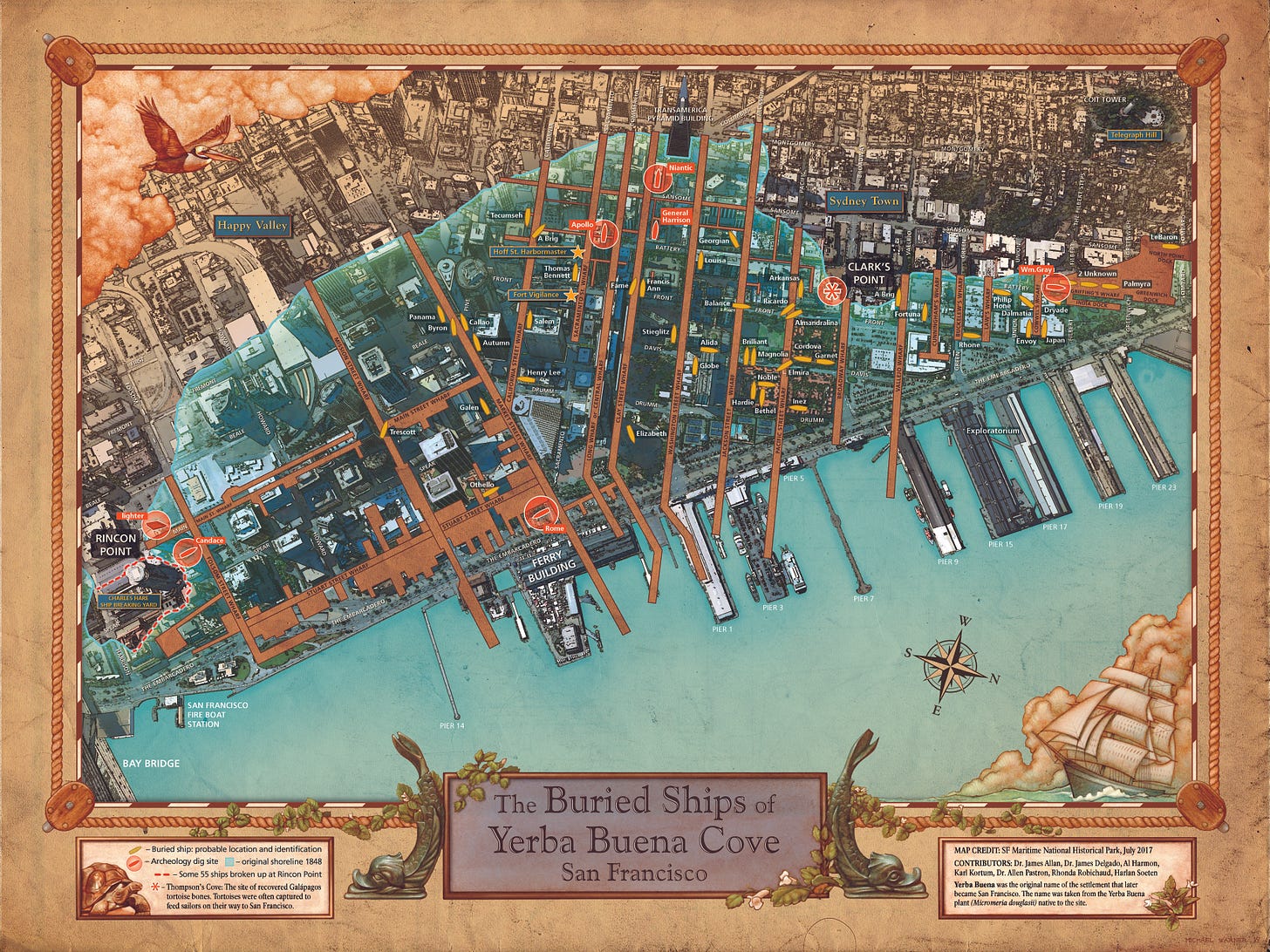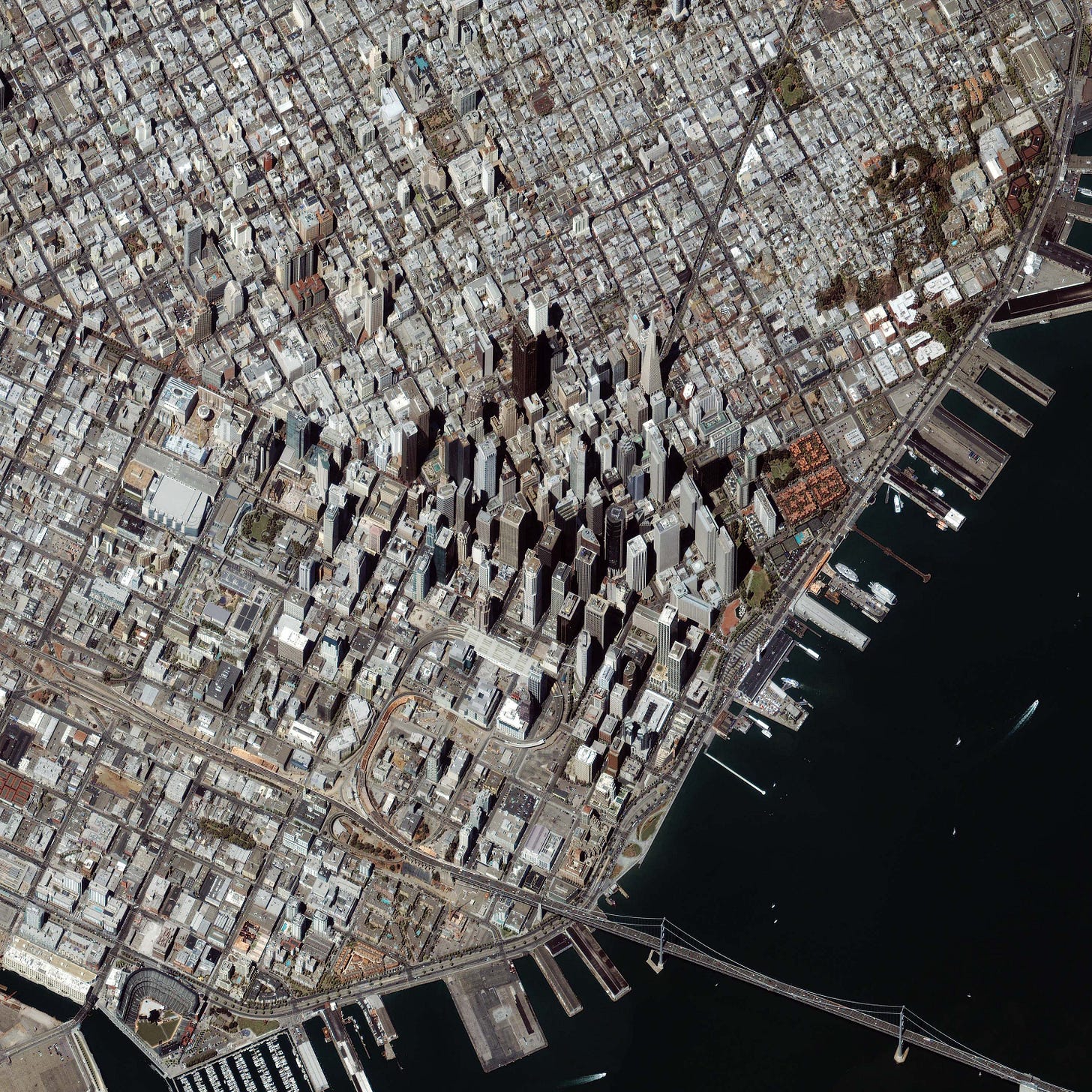Ever Evolving Landscapes
Curious case of ship wrecks underneath San Francisco's financial district and inspiration for the title of this publication
Ship Wrecks under San Francisco’s Financial District
In 1848, James Marshall discovered gold in the American River, which flows through the Sierra Nevada range in northern California before joining the Sacramento River. This discovery sparked the California Gold Rush, attracting thousands of people to California over the next decade. Most of these fortune seekers opted to travel by water, arriving in San Francisco Bay, as it was a more favorable route compared to crossing the arid deserts and treacherous mountain passes of the Sierra Nevada range.
As people crowded the shores of San Francisco Bay through the Golden Gate inlet, they abandoned their ships, hoping to strike gold (literally!) and never return home. Sailors, too, often deserted their vessels to join the gold rush bandwagon. The influx of gold seekers transformed the San Francisco Bay area, which had been a small city of just 1,000 residents before the Gold Rush, into a bustling hub with a population exceeding 100,000.

The ships abandoned along the shore met a variety of fates. Some were repurposed as bars or hotels to cater to the area’s growing population. Others were intentionally sunk to exploit a law that allowed land claims where ships were submerged. In some cases, people were hired to tow ships to specific locations on the shore and sink them, thereby securing prime real estate in the expanding city. Some of the decaying vessels were dismantled and recycled as building materials.
Gradually, sand and earth filled these shipwrecks, pushing the shoreline further out, as published in the map released by the National Park Service in the US shown above. As the city’s population surged due to the gold rush, San Francisco expanded not only in population but also in land area by filling these shipwrecks with sand and earth. This extended part of the city eventually became roughly the financial district today, known for its impressive skyline with some of the tallest buildings in the world.

Evolution of Lands and Societies
In just 150 years, a shoreline once bustling with ships carrying hopeful gold seekers has transformed into a land of towering skyscrapers, as seen in the aerial image of the region below. This evolution is particularly fascinating given the region's location in one of the world's most seismically active areas. What was once a forest of ship masts has turned into a forest of skyscrapers. Earthquake risks, virtually unknown 150 years ago, are now a primary concern for the city’s residents and administration.

State-of-the-art research in earthquake engineering and risk is burgeoning in this region, driven by world-class universities like Stanford and UC Berkeley. Arguably, the relatively new (in a longer geological timeline) nature of risk in the city has inspired researchers from these institutions to focus on these issues, which in turn has also contributed to a global understanding of earthquake risk. The region's administrative bodies are also leaders in addressing earthquake risks, leveraging research, engaging various stakeholders, and envisioning innovative risk mitigation policies.
In an alternate world, without the gold rush, there would have been no shipwrecks, and the region might have developed very differently. Consequently, earthquake risk research would have blossomed in other parts of the world, not a major concern for researchers in the San Francisco Bay Area.
These historical events and how they shape our present remind us that the world is constantly changing in small ways, potentially leading to transformative changes in the future. The path dependencies of changes that shape the things we see today tell a story of the constant flux occurring in our surroundings in a seemingly uncontrollable way, shaped by both natural processes and human activities. Recognizing these changes and actively guiding them towards a better and more resilient future is essential for human settlements to thrive.
The Dynamic Nature of Risks
The title of this publication is partly inspired by the story of the transformation of the San Francisco Bay Area that highlights the “evolving” nature of our landscapes and how they shape the disaster risk of today and the future. Such examples of evolving landscapes are not rare across the globe. Transformations in our physical world and our societies have occurred in the past and have been occurring continuously, some over a few decades and others at a glacial pace over centuries or millennia, all impacting current disaster risk.
Though often imperceptible day-to-day, these gradual changes in our surroundings accumulate over time to reshape the disaster risk landscape. As urban centers expand and infrastructure ages, understanding and managing disaster risks becomes increasingly complex. The ever-changing geographies and corresponding changes to infrastructure and society drive the dynamic nature of risk. Policy decisions for risk mitigation must acknowledge this dynamic nature, requiring foresight and strategic planning to reduce vulnerabilities and enhance resilience against future disasters.
Thank you for reading this essay and joining me on this journey of exploration. If you found it interesting and valuable, I would be grateful if you could share it with just ONE friend or colleague who may also find it intriguing. Also, please feel free to share your thoughts; what made you ponder for a second longer than usual?



Great insight into transformation of landscape and associated risk. Keep it up.